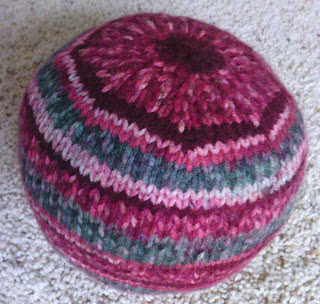Zuzu's Petals is an easy and fast knit if everything works out right. I met the stitch count per inch with size 9 circs but somewhere before joining in the round for the neck opening, I realized my big head just wasn't going fit because the opening was dependent on row gauge. I made a change to smaller needles because the finer yarn version has more row repeats and the worsted weight yarn I was working with was finer than most. Switching needles worked so I went with the pattern repeats for more petals.
Eventually, it became apparent that I might not have enough yarn. The last pattern rounds I dared to knit were numbers 31 and 32, followed by a round to form points on the petals, and then a round of purling to control curling before I fiddled with binding off. Ending my project was an easy solution to my diminishing yarn until I saw an error in the center back in round 32. I figured the beauty of my yarn deserved perfection.
Eventually, it became apparent that I might not have enough yarn. The last pattern rounds I dared to knit were numbers 31 and 32, followed by a round to form points on the petals, and then a round of purling to control curling before I fiddled with binding off. Ending my project was an easy solution to my diminishing yarn until I saw an error in the center back in round 32. I figured the beauty of my yarn deserved perfection.
Un-knitting was tedious but only 4 rounds. Perfection was not to be had. After 3 attempts trying to achieve a loose bind-off and finally succeeding with a single crochet version, I found a dropped stitch in the lace around a petal. At 1 a.m. one doesn't have any reserves or patience for back-knitting so I declared the project done and went to bed. The slightly larger lace hole and missing stitch doesn't show but I know. SIGH!!
The cowl was blocked this morning. Pinned to a pressing mat, sprayed with a mixture of water and Shaklee's liquid fabric softener, and then blasted with the heat of a hand-held hair dryer; the edges have just a faint ripple that goes nicely with the texture of the lace pattern knit too tightly, something I found attractive. The cowl is warm and soft with a beautiful painted pattern. It will dress up a number of turtlenecks in my wardrobe.






































